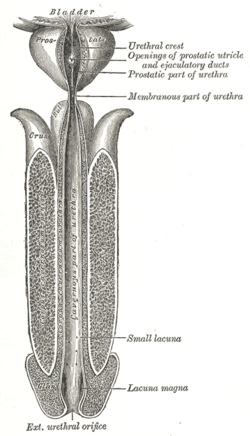Lacuna magna
Appearance
| Lacuna magna | |
|---|---|
 The male urethra laid open on its anterior (upper) surface, lacuna magna labeled near the glans penis (bottom). | |
| Details | |
| Identifiers | |
| Latin | lacuna magna |
| Anatomical terminology | |
In male anatomy, the lacuna magna (also called Guérin's sinus) is the largest of several recesses in the roof of the navicular fossa of the urethra. Its embryologic origin is contested, but recent evidence suggests it and the navicular fossa derive from infiltrating endodermal cells of the urethral plate.[1] In young males, the presence of the lacuna magna is associated with painful urination (dysuria), bloody urine (hematuria), and bloody spotting of underwear.[2][3]
References
- ^ Kurzrock E, Baskin L, Cunha G (1999). "Ontogeny of the male urethra: theory of endodermal differentiation". Differentiation. 64 (2): 115–22. doi:10.1046/j.1432-0436.1999.6420115.x. PMID 10234808.
- ^ Bellinger M, Purohit G, Duckett J, Cromie W (1983). "Lacuna magna: a hidden cause of dysuria and bloody spotting in boys". J. Pediatr. Surg. 18 (2): 163–6. doi:10.1016/S0022-3468(83)80542-9. PMID 6854496.
- ^ Sommer J, Stephens F (1980). "Dorsal urethral diverticulum of the fossa navicularis: symptoms, diagnosis and treatment". J. Urol. 124 (1): 94–7. PMID 7411733.
